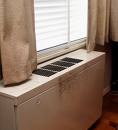Home > Building house > Moisture control
Moisture Control and Ventilation
Moisture control and ventilation are essential aspects of maintaining a healthy and comfortable indoor environment in a house. Proper moisture control helps prevent issues such as mold growth, structural damage, and indoor air quality problems. Ventilation, on the other hand, ensures fresh air circulation, removes pollutants, and regulates humidity levels.

Here's a closer look at moisture control and ventilation in houses:
Moisture Control:
• Proper site selection: Choosing a well-drained site during construction helps prevent moisture issues from the ground.
• Foundation waterproofing: Applying waterproofing materials to the foundation walls and installing drainage systems such as French drains can prevent moisture infiltration.
• Vapor barriers: Installing vapor barriers on walls, floors, and ceilings helps prevent moisture from penetrating into the living spaces.
• Roof maintenance: Regular inspection and maintenance of the roof, including repairing leaks and ensuring proper drainage, are crucial for moisture control.
• Proper grading: Ensuring that the landscape around the house slopes away from the foundation prevents water from pooling around the structure.
• Adequate insulation: Insulating walls, floors, and ceilings not only helps with energy efficiency but also prevents condensation and moisture buildup.
Ventilation:
• Natural ventilation: Designing the house with windows, vents, and openings strategically placed to allow for cross ventilation can promote air circulation and reduce moisture levels.
• Mechanical ventilation: Installing mechanical ventilation systems such as exhaust fans, whole-house fans, or heat recovery ventilators (HRVs) can effectively remove stale air and introduce fresh air into the house.
• Bathroom and kitchen exhaust fans: Properly venting moisture-generating areas like bathrooms and kitchens helps remove excess humidity and prevent moisture-related issues.
• Attic ventilation: Proper attic ventilation, including ridge vents, soffit vents, and gable vents, helps remove excess heat and moisture from the attic space, preventing mold growth and extending the lifespan of the roof.
• Crawl space and basement ventilation: Installing vents, dehumidifiers, or encapsulation systems in crawl spaces and basements can control moisture levels and prevent the buildup of mold and mildew.
Benefits of moisture control and ventilation in houses:
• Prevention of mold and mildew growth: Proper moisture control and ventilation help minimize excess moisture, reducing the risk of mold and mildew growth, which can lead to health issues and structural damage.
• Improved indoor air quality: Effective ventilation removes pollutants, allergens, and odors from the indoor air, promoting a healthier living environment.
• Enhanced comfort: Proper ventilation helps regulate humidity levels, preventing the air from becoming too dry or too humid, which can affect occupant comfort.
• Preservation of the building structure: Controlling moisture levels and preventing excessive humidity helps protect the structural integrity of the house, preventing rot, decay, and damage to building materials.
• Energy efficiency: By controlling moisture and ensuring proper ventilation, homeowners can reduce energy consumption by optimizing heating and cooling systems and reducing the need for excessive dehumidification or heating.
In conclusion, moisture control and ventilation are vital for maintaining a healthy and comfortable indoor environment in a house. Proper moisture control prevents mold growth and structural damage, while effective ventilation ensures fresh air circulation and regulates humidity levels. By implementing appropriate moisture control measures and incorporating efficient ventilation systems, homeowners can enjoy a safe, comfortable, and energy-efficient living space.









